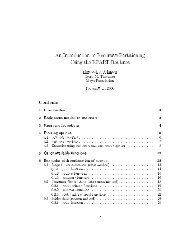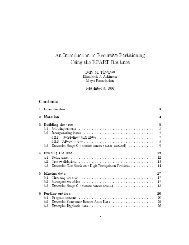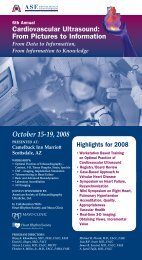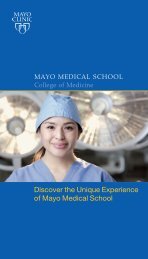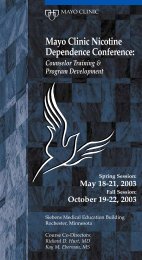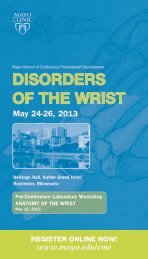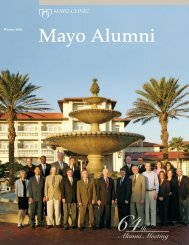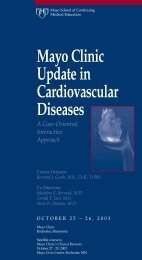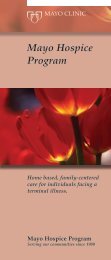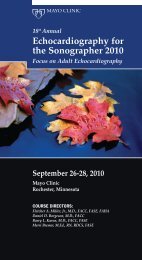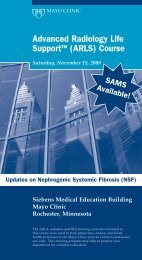Mayo Alumni Magazine 2002 Spring - MC4409-0402 - Mayo Clinic
Mayo Alumni Magazine 2002 Spring - MC4409-0402 - Mayo Clinic
Mayo Alumni Magazine 2002 Spring - MC4409-0402 - Mayo Clinic
Create successful ePaper yourself
Turn your PDF publications into a flip-book with our unique Google optimized e-Paper software.
of Laboratory Medicine and Pathology,<br />
credits the team with envisioning the<br />
LightCycler as a tool that could be<br />
used for clinical assays as well.<br />
“That’s the beauty of the<br />
LightCycler,” says Dr. Wold. “We can<br />
use it today to identify the presence of<br />
anthrax in a research laboratory, but<br />
tomorrow it can be used to diagnose<br />
strep throat in a physician’s office.”<br />
The LightCycler is a modest-looking<br />
instrument.<br />
“It looks like a coffee maker and acts<br />
like a sophisticated hair dryer,” quips<br />
Dr. Cockerill. “It contains a heating<br />
element and a fan that blows air on the<br />
sample to heat and cool it much faster<br />
than the old heating blocks were<br />
capable of doing. It also incorporates a<br />
mechanism to detect if a probe attaches<br />
to the DNA, indicating that an<br />
infectious agent is present.”<br />
Changing the microbiology<br />
landscape<br />
The team began by prioritizing the<br />
list of disease-causing microorganisms<br />
they slated for developmental activities<br />
using the LightCycler. They focused on<br />
common diseases, such as<br />
streptococcal sore throat, whooping<br />
cough and chicken pox. The anthrax<br />
bacillus was well down the list because<br />
anthrax cases had not been seen in the<br />
United States for decades.<br />
For each targeted microorganism,<br />
team members reduced the DNA<br />
extraction step to a few minutes or less.<br />
Then, using the LightCycler<br />
technology, they combined the second<br />
and third steps — amplification and<br />
probing — into a single, 30-minute<br />
analysis. The entire test eventually<br />
took less than one hour.<br />
By September 11, the <strong>Mayo</strong><br />
laboratory stopped using culture tests<br />
for several common infectious diseases.<br />
The rapid PCR tests were faster, cut<br />
costs in half and were more accurate.<br />
“The rapid PCR test can diagnose<br />
219 percent more cases of whooping<br />
cough than conventional culture,”<br />
says Dr. Cockerill. “With increasing<br />
emphasis on molecular diagnostic<br />
testing, patients can soon expect results<br />
from their infectious disease tests on<br />
the same day — just as they do now for<br />
a blood glucose test.”<br />
September 11, the anthrax<br />
outbreaks and the final sprint<br />
“September 11 revealed a<br />
fundamentally different level of<br />
terrorism that caused us to turn the<br />
focus of our development efforts<br />
toward biologic agents,” says Dr. Wold.<br />
Dr. Cockerill was scheduled to teach<br />
at <strong>Mayo</strong> Medical School on the<br />
morning of September 11 but canceled<br />
classes when he saw the level of<br />
distress among the students.<br />
“Instead, I met with Tom Smith and<br />
Jim Uhl,” he explains. “As soon as we<br />
saw the second plane hit the World<br />
Trade Center, we knew that anthrax<br />
attacks would be a possibility.”<br />
“The LightCycler<br />
contains a heating<br />
element and a fan<br />
that blows air on the<br />
sample to heat and<br />
cool it much faster<br />
than the old heating<br />
blocks were capable<br />
of doing. It also<br />
incorporates a<br />
mechanism to detect<br />
if a probe attaches to<br />
the DNA, indicating<br />
that an infectious<br />
agent is present.”<br />
— Franklin Cockerill, M.D.<br />
<strong>Spring</strong> <strong>2002</strong> <strong>Mayo</strong> <strong>Alumni</strong> 5



